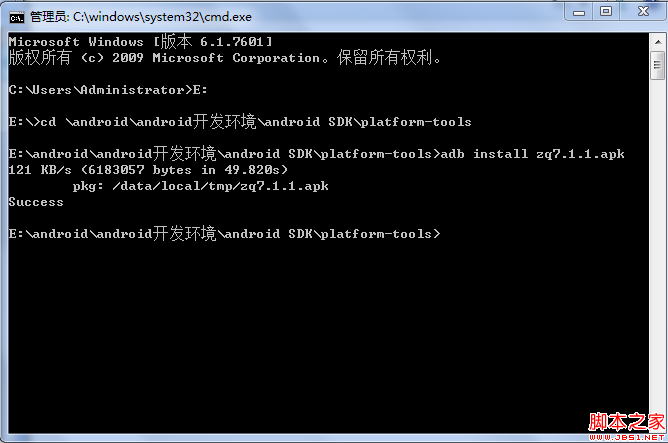編輯:Android開發實例
上一篇簡單介紹了SurfaceView的使用,這次就介紹SurfaceView的雙緩沖使用。雙緩沖是為了防止動畫閃爍而實現的一種多線程應用,基於SurfaceView的雙緩沖實現很簡單,開一條線程並在其中繪圖即可。本文介紹基於SurfaceView的雙緩沖實現,以及介紹類似的更高效的實現方法。
本文程序運行截圖如下,左邊是開單個線程讀取並繪圖,右邊是開兩個線程,一個專門讀取圖片,一個專門繪圖:
對比一下,右邊動畫的幀速明顯比左邊的快,左右兩者都沒使用Thread.sleep()。為什麼要開兩個線程一個讀一個畫,而不去開兩個線程像左邊那樣都“邊讀邊畫”呢?因為SurfaceView每次繪圖都會鎖定Canvas,也就是說同一片區域這次沒畫完下次就不能畫,因此要提高雙緩沖的效率,就得開一條線程專門畫圖,開另外一條線程做預處理的工作。
main.xml的源碼:
- <?xml version="1.0" encoding="utf-8"?>
- <LinearLayout xmlns:android="http://schemas.android.com/apk/res/android"
- android:layout_width="fill_parent" android:layout_height="fill_parent"
- android:orientation="vertical">
- <LinearLayout android:id="@+id/LinearLayout01"
- android:layout_width="wrap_content" android:layout_height="wrap_content">
- <Button android:id="@+id/Button01" android:layout_width="wrap_content"
- android:layout_height="wrap_content" android:text="單個獨立線程"></Button>
- <Button android:id="@+id/Button02" android:layout_width="wrap_content"
- android:layout_height="wrap_content" android:text="兩個獨立線程"></Button>
- </LinearLayout>
- <SurfaceView android:id="@+id/SurfaceView01"
- android:layout_width="fill_parent" android:layout_height="fill_parent"></SurfaceView>
- </LinearLayout>
本文程序的源碼:
- package com.testSurfaceView;
- import java.lang.reflect.Field;
- import java.util.ArrayList;
- import android.app.Activity;
- import android.graphics.Bitmap;
- import android.graphics.BitmapFactory;
- import android.graphics.Canvas;
- import android.graphics.Paint;
- import android.graphics.Rect;
- import android.os.Bundle;
- import android.util.Log;
- import android.view.SurfaceHolder;
- import android.view.SurfaceView;
- import android.view.View;
- import android.widget.Button;
- public class testSurfaceView extends Activity {
- /** Called when the activity is first created. */
- Button btnSingleThread, btnDoubleThread;
- SurfaceView sfv;
- SurfaceHolder sfh;
- ArrayList<Integer> imgList = new ArrayList<Integer>();
- int imgWidth, imgHeight;
- Bitmap bitmap;//獨立線程讀取,獨立線程繪圖
- @Override
- public void onCreate(Bundle savedInstanceState) {
- super.onCreate(savedInstanceState);
- setContentView(R.layout.main);
- btnSingleThread = (Button) this.findViewById(R.id.Button01);
- btnDoubleThread = (Button) this.findViewById(R.id.Button02);
- btnSingleThread.setOnClickListener(new ClickEvent());
- btnDoubleThread.setOnClickListener(new ClickEvent());
- sfv = (SurfaceView) this.findViewById(R.id.SurfaceView01);
- sfh = sfv.getHolder();
- sfh.addCallback(new MyCallBack());// 自動運行surfaceCreated以及surfaceChanged
- }
- class ClickEvent implements View.OnClickListener {
- @Override
- public void onClick(View v) {
- if (v == btnSingleThread) {
- new Load_DrawImage(0, 0).start();//開一條線程讀取並繪圖
- } else if (v == btnDoubleThread) {
- new LoadImage().start();//開一條線程讀取
- new DrawImage(imgWidth + 10, 0).start();//開一條線程繪圖
- }
- }
- }
- class MyCallBack implements SurfaceHolder.Callback {
- @Override
- public void surfaceChanged(SurfaceHolder holder, int format, int width,
- int height) {
- Log.i("Surface:", "Change");
- }
- @Override
- public void surfaceCreated(SurfaceHolder holder) {
- Log.i("Surface:", "Create");
- // 用反射機制來獲取資源中的圖片ID和尺寸
- Field[] fields = R.drawable.class.getDeclaredFields();
- for (Field field : fields) {
- if (!"icon".equals(field.getName()))// 除了icon之外的圖片
- {
- int index = 0;
- try {
- index = field.getInt(R.drawable.class);
- } catch (IllegalArgumentException e) {
- // TODO Auto-generated catch block
- e.printStackTrace();
- } catch (IllegalAccessException e) {
- // TODO Auto-generated catch block
- e.printStackTrace();
- }
- // 保存圖片ID
- imgList.add(index);
- }
- }
- // 取得圖像大小
- Bitmap bmImg = BitmapFactory.decodeResource(getResources(),
- imgList.get(0));
- imgWidth = bmImg.getWidth();
- imgHeight = bmImg.getHeight();
- }
- @Override
- public void surfaceDestroyed(SurfaceHolder holder) {
- Log.i("Surface:", "Destroy");
- }
- }
- /*
- * 讀取並顯示圖片的線程
- */
- class Load_DrawImage extends Thread {
- int x, y;
- int imgIndex = 0;
- public Load_DrawImage(int x, int y) {
- this.x = x;
- this.y = y;
- }
- public void run() {
- while (true) {
- Canvas c = sfh.lockCanvas(new Rect(this.x, this.y, this.x
- + imgWidth, this.y + imgHeight));
- Bitmap bmImg = BitmapFactory.decodeResource(getResources(),
- imgList.get(imgIndex));
- c.drawBitmap(bmImg, this.x, this.y, new Paint());
- imgIndex++;
- if (imgIndex == imgList.size())
- imgIndex = 0;
- sfh.unlockCanvasAndPost(c);// 更新屏幕顯示內容
- }
- }
- };
- /*
- * 只負責繪圖的線程
- */
- class DrawImage extends Thread {
- int x, y;
- public DrawImage(int x, int y) {
- this.x = x;
- this.y = y;
- }
- public void run() {
- while (true) {
- if (bitmap != null) {//如果圖像有效
- Canvas c = sfh.lockCanvas(new Rect(this.x, this.y, this.x
- + imgWidth, this.y + imgHeight));
- c.drawBitmap(bitmap, this.x, this.y, new Paint());
- sfh.unlockCanvasAndPost(c);// 更新屏幕顯示內容
- }
- }
- }
- };
- /*
- * 只負責讀取圖片的線程
- */
- class LoadImage extends Thread {
- int imgIndex = 0;
- public void run() {
- while (true) {
- bitmap = BitmapFactory.decodeResource(getResources(),
- imgList.get(imgIndex));
- imgIndex++;
- if (imgIndex == imgList.size())//如果到盡頭則重新讀取
- imgIndex = 0;
- }
- }
- };
- }
 android底部菜單欄實現原理與代碼
android底部菜單欄實現原理與代碼
上一個項目已經做完了,這周基本上沒事,所以整理了下以前的項目,想把一些通用的部分封裝起來,這樣以後遇到相似的項目就不用重復發明輪子了,也節省了開發效率。今天把de
 Android使用ImageView 制作透明圓弧實例代碼
Android使用ImageView 制作透明圓弧實例代碼
這篇文章主要介紹了Android使用ImageView 制作透明圓弧實例代碼的相關資料,需要的朋友可以參考下 這幾天因為項目需求,需要在
 android 使用虛擬機安裝apk(圖文教程)
android 使用虛擬機安裝apk(圖文教程)
1、啟動虛擬機 2、我的android sdk在“E:\android\android開發環境\android SDK\platform-tools”把要安裝的a
 Android控件系列之Button以及Android監聽器使用介紹
Android控件系列之Button以及Android監聽器使用介紹
學習目的: 1、掌握在Android中如何建立Button 2、掌握Button的常用屬性 3、掌握Button按鈕的點擊事件(監聽器) Button是各種UI中